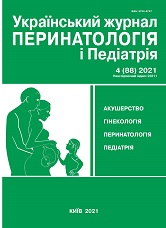Congenital nephrotic syndrome in the practice of a neonatologist (clinical case)
DOI:
https://doi.org/10.15574/PP.2021.88.72.Keywords:
congenital nephrotic syndrome, newborn, molecular genetic testingAbstract
Congenital nephrotic syndrome (CNS) is an inherited disease that is caused by gene mutations and is inherited by an autosomal-recessive mechanism. In most cases, it is associated with genetically mediated defects in the components of the glomerular filtration barrier, especially nephrine and podocytes, with a typical histological picture of diffuse mesenteric sclerosis or focal-segmental glomerulosclerosis. According to genetic research, the primary CNS caused by gene mutations in one of the five genes (NPHS1, NPHS2, WT1, LAMB2, PLCE1) or chromosomal abnormalities. Secondary CNS is combined with other diseases of systemic or renal origin. The onset of the disease manifestation is possible in the antenatal period or during the first three months of life. CNS is manifested by significant hypoproteinemia, proteinuria and diffuse edema. Treatment of congenital nephrotic syndrome is mainly symptomatic therapy, such as: control of edema, azotemia, thyroid function, prevention and treatment of secondary complications (infections and thrombosis). Molecular genetic testing is the «gold» standard for genotyping of this disease. The course of СNS is unfavorable due to the rapid development of end3stage chronic renal failure.
The purpose of article is to expand the knowledge of pediatricians and neonatologists about the clinical, laboratory, instrumental and pathomorphological features of Finnish type of СNS in the neonatal age.
Clinical case. The article presents clinical, laboratory, instrumental, pathomorphological and molecular-genetic features of the Finnish type of CNS with the manifestation in the early neonatal period.
Conclusions. The example of this case shows the necessity of a comprehensive approach at the examination of children suffered from CNS to verify the type of disease, determine the prognosis and treatment tactics.
The research was carried out in accordance with the principles of the Helsinki declaration. The informed consent of the patient was obtained for conducting the studies.
No conflict of interest was declared by the authors.
References
Barratt M, Avner ED, Harmon WE. (1999). Pediatric Nephrology. Fourth Edition. Lippincott Williams&Wilkins. A Wolters Kluwer Company: 765-774.
Bernward GH, Bettina M, Christopher NV et al. (2007). Nephrotic syndrome in the first jear of life: two thirds of cases are caused by mutations in 4 genes (NPHS1, NPHS2, WT1 and LAMB2). Pediatrics. 119 (4): 907-919. https://doi.org/10.1542/peds.2006-2164; PMid:17371932
Brady T, Mitra A, Hooks J. (2014). Maternal serum alpha$fetoprotein level peak at 19-21 weeks gestation and subsequently decline in a NPHS1 sequence variant heterozygote; implications for prenatal diagnosis of congenital nephrosis the of Finnish type. Prenat Diagn. 34: 1-3. https://doi.org/10.1002/pd.4375; PMid:24700530
Holmberg C, Antikainen M, Ronnholm K et al. (1995). Management of congenital nephrotic syndrome of the Finnish type (Review). Pediatr Nephrol. 9: 87-93. https://doi.org/10.1007/BF00858984; PMid:7742232
Jalanko H, Holmberg C, Avner ED, Harmon WE, Niaudet P, Yoshikawa N, Emma F, Goldstein SL. (2016). Congenital Nephrotic Syndrome. In: Pediatric Nephrology. Springer-Verlag, Berlin Heidelberg. 1: 753-769. doi: 10.1007/978-3-662-43596-0-78.
Jalanko Н, Holmberg C. (2009). Congenital nephrotic syndrome. Pediatric Nephrology. Editors Avner ED, Harmon WE, Niaudet P, Yoshikawa N. Springer. 1: 601-619. https://doi.org/10.1007/978-3-540-76341-3_25
Kostyushina IS, Margieva TV, Gusarova TN, Yahyaeva GT, Namazova-Baranova LS, Pushkov AA, Savostyanov KV. (2014). Sluchay netyazhelogo techeniya vrozhdennogo nefroticheskogo sindroma. Pediatricheskaya farmakologiya. 11 (6): 62-65.
Ljungberg P, Holmberg C, Jalanko H. (1997). Infections in infants with congenital nephrosis of the Finnish type. Pediatr Nephrol. 11: 148-152. https://doi.org/10.1007/s004670050246; PMid:9090651
Luchaninova VN, Moskvina EA, Shavkin AL, Zvereva AYu, Kruchina MK. (2019). Vrozhdennyiy nefroticheskiy sindrom: trudnosti diagnostiki i lecheniya. Tihookeanskiy meditsinskiy zhurnal. 4: 95-97. https://doi.org/10.34215/1609-1175-2019-4-95-97
Mauch T, Vernier R, Burke B, Nevins T. (1994). Nephrotic syndrome in the first year of life. Pediatric Nephrology. Ed. Holliday MA, Barrat TM, Avner ED. Baltimor: Williams&Wilkins: 788-803.
Maydannik VG. (2012). Nasledstvennyie variantyi nefroticheskogo sindroma u detey. Mezhdunarodnyiy zhurnal pediatrii, akusherstva i ginekologii. 2 (3): 95-104.
Morozov SL, Dlin VV, Suhorukov VS, Voronkova AS. (2017). Molekulyarna nefropatologiya: novyie vozmozhnosti diagnostiki zabolevaniy pochek. Rossiyskiy vestnik perinatologii i pediatrii. 62 (3): 32-36. https://doi.org/10.21508/1027-4065-2017-62-3-32-36
Salomon R, Cubler MC, Niaudet P. (2000). Genetics of the nephrotic syndrome. Curr Opin Pediat. 12: 129-134. https://doi.org/10.1097/00008480-200004000-00008; PMid:10763762
Downloads
Published
Issue
Section
License
Copyright (c) 2022 Ukrainian journal of Perinatology and Pediatrics

This work is licensed under a Creative Commons Attribution-NonCommercial 4.0 International License.
The policy of the Journal “Ukrainian Journal of Perinatology and Pediatrics” is compatible with the vast majority of funders' of open access and self-archiving policies. The journal provides immediate open access route being convinced that everyone – not only scientists - can benefit from research results, and publishes articles exclusively under open access distribution, with a Creative Commons Attribution-Noncommercial 4.0 international license(СС BY-NC).
Authors transfer the copyright to the Journal “MODERN PEDIATRICS. UKRAINE” when the manuscript is accepted for publication. Authors declare that this manuscript has not been published nor is under simultaneous consideration for publication elsewhere. After publication, the articles become freely available on-line to the public.
Readers have the right to use, distribute, and reproduce articles in any medium, provided the articles and the journal are properly cited.
The use of published materials for commercial purposes is strongly prohibited.

